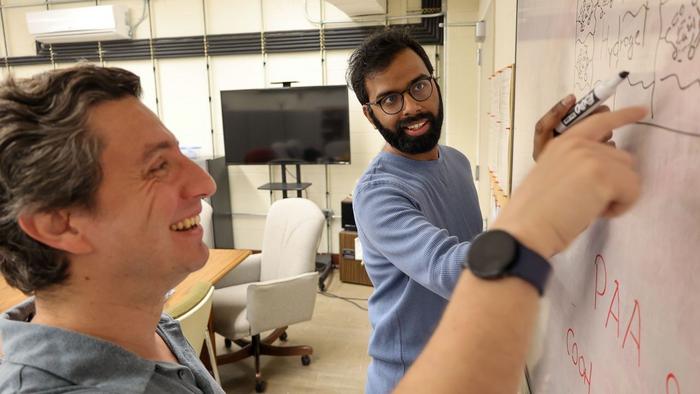In a May 15 paper released in the journal Physical Review Letters, Virginia Tech physicists revealed a microscopic phenomenon that could greatly improve the performance of soft devices, such as agile flexible robots or microscopic capsules for drug delivery.

Credit: Photo by Spencer Coppage for Virginia Tech.
In a May 15 paper released in the journal Physical Review Letters, Virginia Tech physicists revealed a microscopic phenomenon that could greatly improve the performance of soft devices, such as agile flexible robots or microscopic capsules for drug delivery.
The paper, written by doctoral candidate Chinmay Katke, assistant professor C. Nadir Kaplan, and co-author Peter A. Korevaar from Radboud University in the Netherlands, proposes a new physical mechanism that could speed up the expansion and contraction of hydrogels. For one thing, this opens up the possibility for hydrogels to replace rubber-based materials used to make flexible robots—enabling these fabricated materials to perhaps move with a speed and dexterity close to that of human hands.
Soft robots are already being used in manufacturing, where a hand-like device is programmed to grab an item from a conveyer belt—picture a hot dog or piece of soap—and place it in a container to be packaged. But the ones in use now lean on hydraulics or pneumatics to change the shape of the “hand” to pick up the item.
Akin to our own body, hydrogels mostly contain water and are everywhere around us, e.g., food jelly and shaving gel. Katke, Korevaar, and Kaplan’s research appears to have found a method that allows hydrogels to swell and contract much more quickly, which would improve their flexibility and capability to function in different settings.
What did the Virginia Tech scientists do?
Living organisms use osmosis for such activities as bursting seed dispersing fruits in plants or absorbing water in the intestine. Normally, we think of osmosis as a flow of water moving through a membrane, with bigger molecules like polymers unable to move through. Such membranes are called semi-permeable membranes and were thought to be necessary to trigger osmosis.
Previously, Korevaar and Kaplan had done experiments by using a thin layer of hydrogel film comprised of polyacrylic acid. They had observed that even though the hydrogel film allows both water and ions to pass through and is not selective, the hydrogel rapidly swells due to osmosis when ions are released inside the hydrogel and shrinks back again.
Katke, Korevaar, and Kaplan developed a new theory to explain the above observation. This theory tells that microscopic interactions between ions and polyacrylic acid can make hydrogel swell when the released ions inside the hydrogel are unevenly spread out. They called this “diffusio-phoretic swelling of the hydrogels.” Furthermore, this newly discovered mechanism allows hydrogels to swell much faster than what has been previously possible.
Why is that change important?
Kaplan explained: Soft agile robots are currently made with rubber, which “does the job but their shapes are changed hydraulically or pneumatically. This is not desired because it is difficult to imprint a network of tubes into these robots to deliver air or fluid into them.”
Imagine, Kaplan said, how many different things you can do with your hand and how fast you can do them owing to your neural network and the motion of ions under your skin. Because the rubber and hydraulics are not as versatile as your biological tissues, which is a hydrogel, state-of-the-art soft robots can only do a limited number of movements.”
How could this improve our lives?
Katke explained that the process they have researched allows the hydrogels to change shape then change back to their original form “significantly faster this way” in soft robots that are larger than ever before.
At present, only microscopic-sized hydrogel robots can respond to a chemical signal quickly enough to be useful and larger ones require hours to change shape, Katke said. By using the new diffusio-phoresis method, soft robots as large as a centimeter may be able to transform in just a few seconds, which is subject to further studies.
Larger agile soft robots that could respond quickly could improve assistive devices in healthcare, “pick-and-place” functions in manufacturing, search and rescue operations, cosmetics used for skincare, and contact lenses.
Journal
Physical Review Letters
DOI
10.1103/PhysRevLett.132.208201
Article Title
Diffusiophoretic Fast Swelling of Chemically Responsive Hydrogels
Article Publication Date
15-May-2024




